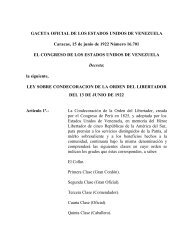Chapter 4
Chapter 4
Chapter 4
Create successful ePaper yourself
Turn your PDF publications into a flip-book with our unique Google optimized e-Paper software.
2<br />
2<br />
F σ 1 ⎛σ ⎞ 1<br />
ε0⎜ ⎟ ε0<br />
A 2ε0 2 ε0<br />
2<br />
P = = = = E<br />
⎝ ⎠<br />
2<br />
(4.4.8)<br />
where<br />
E is the magnitude of the field just above the patch. The pressure is being<br />
transmitted<br />
via the electric field.<br />
4.5 Summary<br />
• The electric flux that passes through a surface<br />
characterized by the area vector<br />
<br />
A = Anˆis<br />
Φ E = EA ⋅ = EAcosθ <br />
where θ is the angle between the electric field E and the unit vector ˆn .<br />
• In general, the electric flux through a surface is<br />
Φ = E⋅ A<br />
<br />
∫∫<br />
E d<br />
S<br />
• Gauss’s law states that the electric flux through any closed Gaussian surface is<br />
proportional<br />
to the total charge enclosed by the surface:<br />
q<br />
Φ E = ∫∫ E⋅ dA=<br />
ε<br />
S<br />
Gauss’s law can be used to calculate the electric field for a system that possesses<br />
planar, cylindrical or spherical symmetry.<br />
• The normal component of the electric field exhibits discontinuity, with<br />
∆ E = σ / ε , when crossing a boundary with surface charge density σ.<br />
n<br />
0<br />
• The basic properties of a conductor are (1) The electric field inside a conductor is<br />
zero; (2) any net charge must reside on the surface of the conductor; (3) the<br />
surface of a conductor is an equipotential surface, and the tangential component<br />
of the electric field on the surface is zero; and (4) just outside the conductor, the<br />
electric field is normal to the surface.<br />
• Electrostatic pressure on a conducting surface is<br />
enc<br />
0<br />
23

















